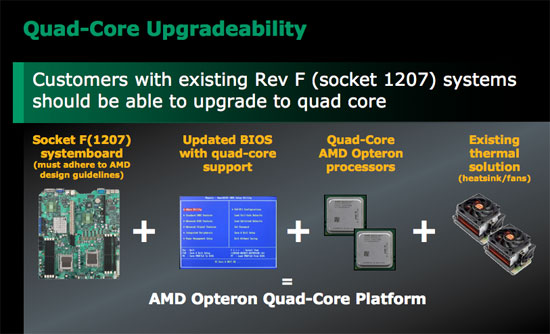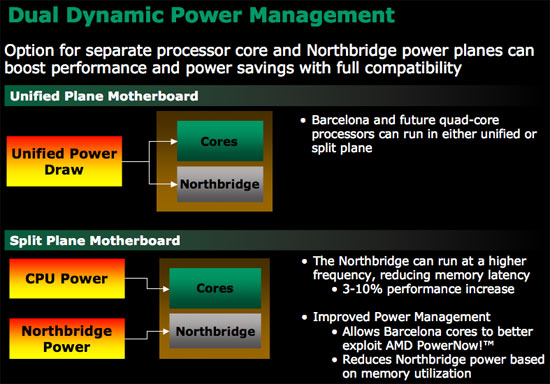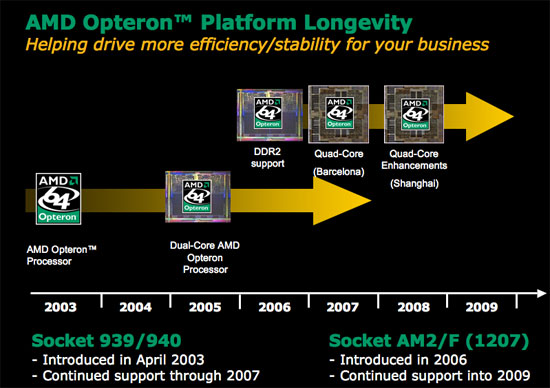New Details on Barcelona Emerge
If you've been following AMD's latest roadmaps then you'll know there are a couple of new sockets on the way. While AMD's next-generation CPUs will work in current Socket-AM2 and Socket-1207 motherboards, a new class of boards will launch with support for Socket-AM2+ and Socket-1207+. Inevitably the question you will ask yourself is: what does the + get you?
The pinout of Socket-AM2 and Socket-AM2+ is identical, and likewise Socket-1207 and 1207+, and thus the same Agena or Barcelona will work in both sockets, which is how AMD is able to guarantee full backwards compatibility with current AM2 and 1207 motherboards. If you do buy a new motherboard that uses either Socket-AM2+ or 1207+, you will get some additional functionality.

Current platforms only support HyperTransport 2.0, while the new + platforms will enable HT3.0 which brings faster link speeds and greater bandwidth. For desktops, a faster HT link won't really change performance, but in multi-socket workstations and servers there will be a benefit.

The more tangible feature is the ability to support split voltage planes. As we mentioned in our preview of AMD's Barcelona architecture, the CPU cores and the Northbridge can operate at different voltages and frequencies. In order to enable this functionality, you need motherboard support, thus if you want the power benefits of having the Northbridge and CPU cores on independent power planes you need an AM2+ or 1207+ motherboard.
It's not all about saving power with split voltage planes, as there's also a performance benefit to going AM2+/1207+. When the Northbridge is placed on its own power plane, the motherboard can actually apply more voltage to it than the CPU cores and run it at a slightly higher frequency on the order of a 200 - 400MHz increase. The Northbridge is an extremely low power part of the CPU die and an increase in voltage/clock frequency results in a minor increase in TDP, but it can drive a disproportionately large increase in performance.
With AM2+/1207+ systems, the Northbridge runs at a higher frequency and thus the memory controller sees slightly lower latencies. The shared L3 cache also operates on the same power plane as the Northbridge, reducing L3 cache latency as well. AMD expects the overall performance advantage by going with AM2+/1207+ to be on the order of 3 - 10% over current motherboards.

While your current motherboards will work with AMD's forthcoming CPUs, you'll get better performance out of upcoming Socket-AM2+ and Socket-1207+ platforms. AMD does plan on supporting both AM2 and 1207 into 2009, so you can expect a continued upgrade path for your AMD platforms well after Agena/Barcelona.
If you've been following AMD's latest roadmaps then you'll know there are a couple of new sockets on the way. While AMD's next-generation CPUs will work in current Socket-AM2 and Socket-1207 motherboards, a new class of boards will launch with support for Socket-AM2+ and Socket-1207+. Inevitably the question you will ask yourself is: what does the + get you?
The pinout of Socket-AM2 and Socket-AM2+ is identical, and likewise Socket-1207 and 1207+, and thus the same Agena or Barcelona will work in both sockets, which is how AMD is able to guarantee full backwards compatibility with current AM2 and 1207 motherboards. If you do buy a new motherboard that uses either Socket-AM2+ or 1207+, you will get some additional functionality.

Current platforms only support HyperTransport 2.0, while the new + platforms will enable HT3.0 which brings faster link speeds and greater bandwidth. For desktops, a faster HT link won't really change performance, but in multi-socket workstations and servers there will be a benefit.

The more tangible feature is the ability to support split voltage planes. As we mentioned in our preview of AMD's Barcelona architecture, the CPU cores and the Northbridge can operate at different voltages and frequencies. In order to enable this functionality, you need motherboard support, thus if you want the power benefits of having the Northbridge and CPU cores on independent power planes you need an AM2+ or 1207+ motherboard.
It's not all about saving power with split voltage planes, as there's also a performance benefit to going AM2+/1207+. When the Northbridge is placed on its own power plane, the motherboard can actually apply more voltage to it than the CPU cores and run it at a slightly higher frequency on the order of a 200 - 400MHz increase. The Northbridge is an extremely low power part of the CPU die and an increase in voltage/clock frequency results in a minor increase in TDP, but it can drive a disproportionately large increase in performance.
With AM2+/1207+ systems, the Northbridge runs at a higher frequency and thus the memory controller sees slightly lower latencies. The shared L3 cache also operates on the same power plane as the Northbridge, reducing L3 cache latency as well. AMD expects the overall performance advantage by going with AM2+/1207+ to be on the order of 3 - 10% over current motherboards.

While your current motherboards will work with AMD's forthcoming CPUs, you'll get better performance out of upcoming Socket-AM2+ and Socket-1207+ platforms. AMD does plan on supporting both AM2 and 1207 into 2009, so you can expect a continued upgrade path for your AMD platforms well after Agena/Barcelona.










55 Comments
View All Comments
Regs - Friday, May 11, 2007 - link
Tight lipped does make AMD look bad right now but could be even worse for them after Intel has their way with the information alone. I'm not talking about technology or performance, I'm talking about marketing and pure buisness politics.Intel beat AMD to market by a huge margin and I think it would be insane for AMD to go ahead and post numbers and specifications while Intel has more than enough time to make whatever AMD is offering look bad before it hits the shelves or comes into contact with a Dell machine.
strikeback03 - Friday, May 11, 2007 - link
Intel cut the price of all the C2D processors by one slot in the tree - the Q6600 to the former price of the E6700, the E6700 to the former price of the E6600, the E6600 to the former price of the E6400, etc. Anandtech covered this a month or so ago after AMD cut prices.
I wonder as well. Will it be relatively easy to mix and match features as needed? Or will the offerings be laid out that most people end up paying for a feature they don't want for each feature they do?
yyrkoon - Friday, May 11, 2007 - link
Yeah, its hard to take this peice of 'information' without a grain of salt added. On one hand you have the good side, true integrated graphics (not this shitty thing of the past, hopefully . . .), with full bus speed communication, and whatnot, but on the other hand, you cut out discrete manufactuers like nVidia, which in the long run, we are not only talking about just discrete graphics cards, but also one of the best/competing chipset makers out there.
Regs - Friday, May 11, 2007 - link
The new attitude Anand displays with AMD is more than enough and likely the whole point of the article.AMD is changing for a more aggressive stance. Something they should of done years ago.
Stablecannon - Friday, May 11, 2007 - link
Aggressive? I'm sorry could you refer me to the article that gave you that idea. I must have missed while I was at work.
Regs - Friday, May 11, 2007 - link
Did you skim?There were at least two whole paragraphs. Though I hate to qoute so much content, I guess it's needed.
sprockkets - Friday, May 11, 2007 - link
What is there that is getting anyone excited to upgrade to a new system? We need faster processors and GPUs? Sure, so we can play better games. That's it?Now we can do HD content. I would be much more excited about that except it is encumbered to the bone by DRM.
I just wish we had a competent processor that only needs a heatsink to be cooled.
Not sure what you are saying since over a year ago they would have been demoing perhaps 65nm cells, but whatever.
And as far as Intel reacting, they are already on overdrive with their product releases, FSB bumps, updating the CPU architecture every 2 years instead of 3, new chipsets every 6 months, etc. I guess when you told people we would have 10ghz Pentium 4's and lost your creditbility, you need to make up for it somehow.
Then again, if AMD shows off benchmarks, what good would it do? The desktop varients we can buy are many months away.
Viditor - Saturday, May 12, 2007 - link
In April of 2006, AMD demonstrated 45nm SRAM. This was 3 months after Intel did the same...
sprockkets - Friday, May 11, 2007 - link
To reply to myself, perhaps the Fusion project is the best thing coming. If we can have a standard set of instructions for cpu and gpu, we will no longer need video drivers, and perhaps we can have a set that works very low power. THAT, is what I want.Wish they talked more of DTX.
TA152H - Friday, May 11, 2007 - link
I agree with you about only needing a heat sink, I still use Pentium IIIs in most of my machines for exactly that reason. I also prefer slotted processors to the lame socketed ones, but they cost more and are unnecessary so I guess they aren't going to come back. They are so much easier to work with though.I wish AMD or Intel would come out with something running around 1.4 GHz that used 10 watts or less. I bought a VIA running at 800 MHz a few years ago, but it is incredibly slow. You're better off with a K6-III+ system, you get better performance and about the same power use. Still, it looks like Intel and AMD are blind to this market, or minimally myopic, so it looks like VIA/Centaur is the best hope there. The part I don't get is why they superpipeline something for high clock speed when they are going for low power. It seems to me an upgraded K6-III would be better at something like this, since by comparison the Pentium/Athlon/Core lines offer poor performance for the power compared to the K6 line, considering it's made on old lithography. So does the VIA, and that's what it's designed for. I don't get it. Maybe AMD should bring it back as their ultra-low power design. Actually, maybe they are. On a platform with reasonable memory bandwidth, it could be a real winner.